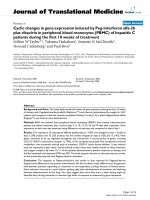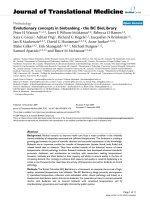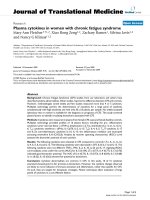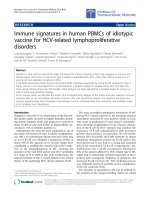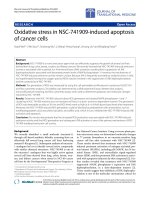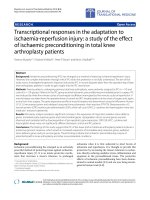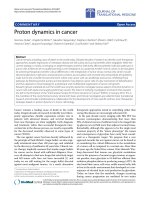báo cáo hóa học:" Respiratory symptoms in adults are related to impaired quality of life, regardless of asthma and COPD: results from the European community respiratory health survey" docx
Bạn đang xem bản rút gọn của tài liệu. Xem và tải ngay bản đầy đủ của tài liệu tại đây (221.8 KB, 8 trang )
RESEARC H Open Access
Respiratory symptoms in adults are related to
impaired quality of life, regardless of asthma and
COPD: results from the European community
respiratory health survey
Marianne Voll-Aanerud
1,2*
, Tomas ML Eagan
1,3
, Estel Plana
2
, Ernst R Omenaas
1,4
, Per S Bakke
1,3
, Cecilie Svanes
1
,
Valerie Siroux
5
, Isabelle Pin
5
, Josep M Antó
2,6
, Benedicte Leynaert
7
Abstract
Background: Respiratory symptoms are common in the general population, and their presence is related to
Health-related quality of life (HRQoL). The objective was to describe the association of respiratory symptoms with
HRQoL in subjects with and without asthma or COPD and to investigate the role of atopy, bronchial
hyperresponsiveness (BHR), and lung function in HRQoL.
Methods: The European Community Respiratory Health Survey (ECRHS) I and II provided data on HRQoL, lung
function, respiratory symp toms, asthma, atopy, and BHR from 6009 subjects. Generic HRQoL was assessed through
the physical component summary (PCS) score and the mental component summary (MCS) score of the SF-36.
Factor ana lyses and linear regressions adjusted for age, gender, smoking, occupation, BMI, comorbidity, and study
centre were conducted.
Results: Having breathlessness at rest in ECRHS II was associated with mean sc ore (95% CI) impairment in PCS of
-8.05 (-11.18, -4.93). Impairment in MCS score in subjects waking up with chest tightness was -4.02 (-5.51, -2.52).
The magnitude of HRQoL impairment associated with respiratory symptoms was similar for subjects with and
without asthma/COPD. Adjustments for atopy, BHR, and lung function did not explain the association of respiratory
symptoms and HRQoL in subjects without asthma and/or COPD.
Conclusion: Subjects with respiratory symptoms had poorer HRQoL; including subjects without a diagnosis of
asthma or COPD. These findings suggest that respiratory symptoms in the absence of a medical diagnosis of
asthma or COPD are by no means trivial, and that clarifying the nature and natural history of respirato ry symptoms
is a relevant challenge.
Several community studies have estimated the prevalence of common respiratory symptoms like cough, dyspnoea,
and wheeze in adults [1-3]. Although the prevalence varies to a large degree between studies and geographical
areas, respiratory symptoms are quite common. The prevalences of respiratory symptoms in the European Com mu-
nity Respiratory Health Study (ECRHS) varied from one percent to 35% [1]. In fact, two studies have rep orted that
more than half of the adult population suffers from one or more respiratory symptoms [4,5].
Respiratory symptoms are important markers of the risk of having or developing disease. Respiratory symptoms
have been shown to be predictors for lung function decline [6-8], asthma [9,10], and even all-cause mortality in a
general population study [11]. In patients with a known diagnosis of asthma or chronic obstructive pulmonary dis-
ease (COPD), respiratory symptoms are important determinants of reduced health related quality of life (HRQoL)
[12-15]. The prevalence of respiratory symptoms exceeds the combined prevalences of asthma and COPD, and
* Correspondence:
1
Institute of Medicine, University of Bergen, Bergen, Norway
Full list of author information is available at the end of the article
Voll-Aanerud et al. Health and Quality of Life Outcomes 2010, 8:107
/>© 2010 Voll-Aanerud et al ; licensee BioMed Central Ltd. This is an Open Access article distributed under the terms of the Creative
Commons Attribu tion License ( which permits unrestricted use, distribution, and
reproduction in any medium, provided the original work is properly cited.
both asthma and COPD are frequently undiagnosed diseases [16-18]. Thus, the high prevalence of respipratory
symptoms may mirror undiagnosed and untreated disease.
The common occurrence of respiratory symptoms calls for attention to how these symptoms affect health also in
subjects with no diagnosis of obstructive airways disease. Impaired HRQoL in the presence of respiratory symptoms
have been found in two population-based studies [6,19], but no study of respiratory sypmtoms and HRQoL have
separate analyses for subjects with and without asthma and COPD, and no study provide information about exten-
sive objecti ve measurements of respiratory heal th.
The ECRHS is a randomly sampled, mul ti-cultural, population based cohort study. The ECRHS included measure-
ments of atopy, bronchial hyper responsiveness (BHR), and lung function, and offers a unique opportunity to inves-
tigate how respiratory symptoms affect HRQoL among subjects both with and without obstructive lung disease.
In the present paper we aimed to: 1) Describe the relationship between respiratory symptoms and HRQoL in an
international adult general population and: 2) To assess whether this relationship varied with presence of asthma
and/or COPD, or presence of objective functional markers like atopy and BHR.
Methods
Study population
The ECRHS I [20] was undertaken in 1991 through 1993,
and comprised representative population samples of adults
aged 20-44 years in 48 centres in 22 countries. Altogether
137 619 subjects completed a postal questionnaire on
respiratory health, giving a median response rate of 78%
(stage I). Randomly selected representative subsamples of
subjects from 36 centres participated in interviews and
standardised c linical testing (ECRHS I stage II). The
ECRHS II [21] was a follow-up study of respondents to
ECRHS I stage II, conducted from 1998 through 2002. Of
the invited, a total of 11 168 responded (response rate
76%). The respondents completed interviews and standar-
dised clinical testing with blood tests, spirometry, and
methacholine challenge. A total of 6009 subjects from 24
centres in 11 countries completed data regarding respira-
tory symptoms, HRQoL, and lung function in the ECHRS
II. The regional ethics committees approved the study,
and all participants signed informed consent. The full pro-
tocol is available at .
Questionnaire information
Information on respiratory symptoms was obtained in
ECRHS II by questions 1-11 listed in appendix 1.
Asthma was defined as ever having had asthma, ques-
tion 12 in appendix 1 (ECRHS II).
Smoking was categorized as never-, ex- and current,
where the current smokers were the ones that reported
having smoked during the last month in the ECRHS II.
The longest held job during the follow up period was
used as a marker of s ocioeconomic status, and classified
into 5 groups as 1) managers and professionals; 2) techni-
cians; 3) other non-manual workers; 4) manual workers;
and 5) non-classified workers. Data on comorbidities
were obtained by the questions listed in appendix 2.
Presence of comorbidity was included as a dichotomized
variable.
The Short Form-36 (SF-36) questionnaire was used to
assess HRQoL in the ECRHS II. The SF-36 is a standar-
dized, widely used and validated general HRQoL ques-
tionnaire, which is translated into several languages [22].
It includes 36 questions from which the physical com-
ponent summary (PCS) and t he mental component
summary (MCS) were co mputed as described in the SF-
36 User’s Manual [23]. The scores were transformed so
that the mean score was 50 and the standard deviation
was 10 [24]. A higher score indicates better quality of
life. I n clinical trials , a 5 point change in the M CS and
PCS are regarded as clinically relevant, whereas statisti-
cal significance can be reached with changes in 1-2
points in the scores.
Objective measurements
Pre-bronchodilator lung function (forced expiratory
volume in one second (FEV
1
) and forced vital capacity
(FVC)) and BHR were measured by standard methods
[21]. BHR was defined as a 20% reduction in FEV
1
(PD
20
) after methacholine challenge, with a maximum
cumulative methacholine dose of 2 mg [20]. COPD was
defined and classified according to the Global initiative
for Obstructive Lung Disease (GOLD) [25], i.e FEV
1
/
FVC < 0.70. Because the number of subjects with FEV
1
< 50% predicted wer e small (COPD GOLD stage III and
IV), these were grouped together. Specific IgE levels
were measured with the Pharmacia CAP System [26],
and atopy was defined as assay results > 0.35 kU/L for
any of the following aller gens : house dust mite (Derma-
tophagoides Pteronyssinus), timothy grass, cat and mould
(Cladosporium Herbarum).
Statistical analyses
The statistical software Stata version 10.1 was used for
the s tatistical analyses [27]. The bivariate relationships
between the outcome variables (PC S and MCS) and the
respiratory symptoms were described by means and
Voll-Aanerud et al. Health and Quality of Life Outcomes 2010, 8:107
/>Page 2 of 8
standard deviations and tested with Kruskal Wallis and
Wilcoxon rank-sum tests. Nonparametric test were used
due to skewed distr ibutions of the S F-36 scores. The
relationship between the SF-36 scores and each of the
symptom variables were investigated in robust multiple
linear regression models, with adjustments for age, gen-
der, smoking, occupation, body mass index (BMI),
comorbidity, and study centre. Stratified analyses were
performed with respect to diagnosis (neither asthma nor
COPD; and asthma and/or COPD). Respiratory symp-
toms often occur together, causing probl ems of co-line-
arity if included toge ther, in a mutually adjusted model.
Therefore, we used exploratory factor analysis, where
symptoms with high level of covariance were summar-
ized in a fac tor. This yields an estimate of the associa-
tion between having one of the symptoms in the factor,
regardless of which, and HRQoL. The factors substituted
the observed symptom variables in multiple linear
regression analysis with respect to the SF-36 scores,
adjusted for atopy, BHR, and FEV
1
in addition to age,
gender, smoking, occupation, BMI, comorbidity, and
study centre.
Results
Demographic details of the study population (ECRHS II)
are given in tab le 1. In bivariate analyses, both PCS and
MCS varied significantly with presence o f asthma, gen-
der, age, smoking, occupation, BMI, comorbidity, BHR,
but not with atopy. PCS varied wi th COPD stage, while
MCS did not.
All the respiratory symptoms were significantly related
to both PCS and MCS, the scores being lower in subjects
reporting symptoms (table 2). Breathlessness at rest was
the symptom related to the lowest score, both for PCS
and MCS. The least impairment in the scores was
observed in subjects with cough in the night. A similar
pattern of score decrement was observed in multivariate
analyses, adjusting for age, gender, smoking, comorbidity,
occupation, BMI, and study centre (table 3). The i mpair-
ment in HRQoL associated with the symptoms was more
pronounced for PCS than for MCS.
All the symptoms except breathlessness at night were
related to MCS. Breathlessness at rest and waking up
with chest tightness were associated with the greatest
HRQoL impairment, both in PCS and MCS (table 3).
The adjusted relationship between the symptoms and
the HRQoL scores were further explored by analyses
stratified by asthm a and/or COPD (additional file 1).
The relationship between wheeze and breathlessness
and the HRQoL scores was similar, whether the subjects
had asthma and/or COPD or not, with the exce ption of
breathlessness at rest, which was significantly low er in
subjects without asthma and/or COPD compared to
those with any of these diagnoses. For cough and
phlegm symptoms, the impairment in PCS was some-
what higher in subjects with asthma and/or COPD com-
pared to subjects without these diseases.
Additional analyses assessing the respiratory symp-
toms-HRQo L relationship in thos e with a sthma and in
those with COPD separate ly s howed that these relation-
ships did not differ overtly b etween subjects with
asthma and subjects with COPD (data not shown).
The results of the factor analysis are shown in table 4.
Two factors were retained. Symptoms indicated in ques-
tions 1-6 (appendix 1) correlated highly and founded
the basis fo r the factor named “wheeze or breathless-
ness” , while questions 7-11 formed a factor for “chronic
cough or phlegm”. Table 4 displays the results of two
multiple linear regression mode ls with res pect to PCS
and MCS, with the two sympt om factors as explanatory
variables. Presence of symptoms related to “wheeze or
breathlessness” was associated with almost twice the
PCS impairment compared to presence of symptoms
related to “chronic cough or phlegm” .Thefirstmodel
was ad justed for age, gender, smoking, occupation, BMI,
comorbidity, and study centre. The second was also
adjusted for atopy, BHR, and FEV
1
. The coefficie nts for
the symptom factors did not change significantly when
adjusted for atopy, BHR, and FEV
1
.
Discussion
To our knowledge, this is the first international general
population study assessing the association between
respiratory symptoms and HRQoL. The ass ociation
between respiratory symptoms and HRQoL did not
depend on having a specific diagnosis of asthma or COPD,
as the association was similar in subjects with and without
these diseases. Furthermore, in subjects without asthma
and/or COPD, the impairment in HRQoL associated with
the respiratory symptoms was neither explained by atopy,
BHR, nor impairment of lung function.
HRQoL and other diseases
One of the advantages of using a general HRQoL ques-
tionnaire like the SF-36 is that it allows fo r comparison
between different populations. In a Norwegian study
where the HRQoL measured by SF-36 of patients with
rheumatoid arthritis, epilepsy, angina pectoris, asthma
and COPD were compared, and the patients with
COPD and rheumatoid arthritis had the lowest physical
scores [28]. The mean PCS of patients with COPD was
45, in other words in the same magnitude as the score
decrements as the respiratory symptoms investigat ed in
the present study. In a German study evaluating the
HRQoL of patients in general practices, the adjusted
mean PCS decrements of patients with COPD and
asthma were 4.2 points, also comparable to the impair-
ment of PCS scores we found in ou r study [29]. Our
Voll-Aanerud et al. Health and Quality of Life Outcomes 2010, 8:107
/>Page 3 of 8
study elaborates on the association between respiratory
disease and HRQoL by highlighting the importance of
respiratory symptoms, and not only diagnosed disease in
this association.
Chronic respiratory symptoms can be caused by other
conditions than asthma and COPD. Obesity, heart dis-
eases, hypertension w ith congestive heart failure, and
cancer with metastasis to t he lungs can have similar
symptomatology. In the current study, both BMI and
comorbidities were included as adjustment variables in
the analyses. Of the 6009 subjects, 45.8% had no comor-
bidities 33.2% had one or more, and in 21.0% data on
comorbidities were missing. To evaluate if the observed
ass ociations between respirator y symptoms and HRQo L
could be due to residual confounding by comorbidity,
the analyses presented in additional file 1 were also con-
ducted in subjects without comorbidities. In this sub-
group, there were still significant associations between
respiratory symptoms and HRQoL, both in subjects with
and without asthma and/or COPD (data not shown).
Table 1 Charachteristis of subjects in ECRHS II, and mean physical component summar (PCS) and mental component
summary (MCS) values according to the subjects characteristics
PCS MCS
n Mean (SD)
p
Mean (SD)
p
COPD
GOLD stage I 236 48.7 (9.9) < 0.001 49.5 (10.4) 0.406
GOLD stage II 90 46.1 (10.0) 49.6 (10.9)
GOLD stage III/IV 10 34.6 (11.7) 54.9 (7.4)
Asthma
No 5368 50.5 (8.8) < 0.001 50.2 (10.4) < 0.001
Yes 598 45.6 (12.0) 48.1 (12.4)
Gender
Female 3075 49.5 (9.8) < 0.001 48.9 (11.3) < 0.001
Male 2934 50.5 (8.8) 51.2 (9.7)
Age in tertiles
28-39 years 2000 51.3 (8.3) < 0.001 49.6 (10.7) < 0.001
39.1-47 years 2021 50.2 (8.3) 49.6 (10.8)
47.1-56.5 years 1988 48.4 (10.3) 50.8 (10.4)
Smoking
Never 2541 50.4 (9.3) < 0.001 50.6 (10.3) < 0.001
Ex 1678 50.2 (9.0) 50.3 (10.1)
Current 1737 49.3 (9.7) 48.8 (11.5)
Occupation
Managers and professionals 1829 51.2 (8.5) < 0.001 50.0 (10.1) < 0.001
Technicians 1115 50.9 (8.3) 50.3 (10.3)
Other non manual 1492 49.7 (9.6) 49.4 (11.3)
Manual 1185 48.6 (10.0) 51.1 (10.3)
Non classified 388 47.6 (11.1) 48.4 (11.9)
Body Mass Index
< 20 2739 51.3 (8.4) < 0.001 49.5 (10.7) < 0.001
20-24.9 253 50.6 (9.3) 47.8 (11.3)
25-29.9 2106 49.4 (9.4) 50.9 (10.1)
30+ 773 47.0 (11.0) 50.5 (11.4)
Comorbidity
No 2750 52.0 (7.5) < 0.001 51.3 (9.2) < 0.001
Yes 1996 47.8 (10.7) 48.0 (12.0)
Atopy
No 3978 49.9 (9.5) 0.359 49.7 (10.9) 0.064
Yes 1565 50.2 (9.1) 50.7 (9.9)
Bronchial hyperresponsiveness
No 3961 50.9 (8.6) < 0.001 50.3 (10.3) < 0.001
Yes 577 48.9 (9.9) 48.0 (11.8)
Voll-Aanerud et al. Health and Quality of Life Outcomes 2010, 8:107
/>Page 4 of 8
HRQoL, COPD, and asthma
In the current analyses, we chose to join self-reported
asthma and spirometrically defined COPD in one group.
Firstly, aging is an established risk factor for COPD
[17,30,31]. The risk of developing COPD is substantially
higher in subjects over 45 years of age [17] compared to
younger subjects, and the majority of our study popula-
tion was under 45 years. Secondly, among our study
participants, 336 subjects (5.6%) had airway obstruction
measur ed with pre-bronchodilatator spirometry, and the
majority of these had FEV
1
> 80% of predicted. Most
likely, a large number of these subjects have reversible
airway obstruction [32], indicating asthma and not
COPD. Thirdly, there where 102 subjects that reported
ever having had asthma in addition to having FEV
1
/FVC
< 0.70. Thus, in a population study as this classification
error between asthma and COPD is difficult to avoid.
Since the main focus of the study was the subjects wit h-
out ob structive lung disease, we chose to gro up asthma
and COPD together.
A priori, respiratory symptoms without a known cause
will probably be more worrying than symptoms with a
recognized pathological origin. A study of asthma and
COPD patients in the Netherlands showed that knowl-
edge about both asthma and COPD was related to bet-
ter adaptation to these diseases [33]. Kno wledge of
diseaseislikelytovaryinthegroupofasthmaand/or
COPD in our study, since asthma was self-r eported and
COPD was based on spirometric measurements of air-
flow limitation. To account for an eventual positive
effect of k nowledge of disease we conducted ana lyses
stratified b y asthma and COPD. However, the HRQoL
Table 2 Mean (Standard Deviation) physical component summary (PCS) and mental c summary (MCS) in subjects with
and without respiratory symptoms in the ECRHS II
PCS MCS
Symptom No Yes No Yes
No
n
Yes
n
Mean(SD) Mean(SD) p Mean(SD) Mean(SD) p
Wheezing 4690 1317 50.9(8.5) 46.9(8.5) * 50.4(10.3) 48.5(11.8) *
Wheezing and breathlessness 5311 668 50.6(8.8) 45.4(11.7) * 50.3(10.4) 47.8(12.1) *
Wheezing without a cold 5199 761 50.6(8.8) 45.4(11.7) * 50.3(10.4) 48.3(11.9) *
Woken up by tightness in chest 5228 775 50.7(8.6) 45.3(12.1) * 50.6(10.2) 46.0(12.5) *
Breathlessness at rest 5659 339 50.3(8.9) 44.5(13.3) * 50.3(10.3) 44.8(13.6) *
Breathlessness after exercise 4948 1049 50.9(8.5) 45.7(11.6) * 50.7(10.1) 46.8(12.3) *
Breathlessness at night 5645 350 50.3(9.0) 45.3(12.1) * 50.2(10.5) 47.2(12.2) *
Cough at night 4251 1754 50.9(8.5) 47.9(10.6) * 50.5(10.3) 48.9(11.2) *
Cough in the morning 5258 738 50.5(9.0) 46.9(10.7) * 50.4(10.4) 47.3(11.7) *
Cough in the winter 5233 760 50.6(8.8) 46.0(11.5) * 50.4(10.2) 47.2(12.8) *
Chronic chough 5557 404 50.4(8.9) 45.1(12.2) * 50.2(10.4) 47.1(12.8) *
Phlegm in the morning 5172 816 50.5(8.9) 46.9(11.1) * 50.3(10.5) 48.2(11.6) *
Phlegm in the winter 5342 601 50.5(8.9) 46.0(11.7) * 50.2(10.5) 48.1(11.8) *
Chronic phlegm 5539 395 50.3(9.0) 46.1(12.1) * 50.1(10.5) 48.3(11.9) *
Table 3 Association (coefficient and 95% confidence
interval) of the physical component summary (PCS) and
the mental component summa (MCS) with persistent*
respiratory symptoms
PCS MCS
coef 95% CI coef 95% CI
Persistent symptoms
Wheezing -4.06 (-4.95, -3.16) -2.45 (-3.41, -1.49)
Wheezing and
breathlessness
-6.08 (-7.51, -4.65) -2.19 (-3.66, -0.72)
Wheezing without a
cold
-4.13 (-5.43, -2.84) -1.88 (-3.14, -0.61)
Woken up by tightness
in chest
-7.15 (-8.65, -5.65) -4.02 (-5.51, -2.52)
Breathlessness at rest -8.05 (-11.18, -4.93) -3.81 (-6.68, -0.94)
Breathlessness after
exercise
-5.93 (-7.11, -4.75) -2.92 (-4.12, -1.72)
Breathlessness at night -5.68 (-7.91, -3.45) -0.78 (-2.95,1.40)
Cough at night -3.68 (-4.46, -2.91) -2.07 (-2.92, -1.21)
Cough in the morning -3.68 (-4.89, -2.46) -2.04 (-3.31, -0.76)
Cough in the winter -4.74 (-6.05, -3.43) -4.08 (-5.50, -2.67)
Chronic chough -4.83 (-6.77, -2.90) -3.96 (-6.01, -1.90)
Phlegm in the morning -3.92 (-5.04, -2.80) -2.04 (-3.21, -0.86)
Phlegm in the winter -4.41 (-5.90, -2.93) -2.80 (-4.33, -1.28)
Chronic phlegm -2.64 (-4.42, -0.86) -2.99 (-5.03, -0.94)
*Persistent meaning presence of the symptom both in ECRHS I and II.
Coefficients give deviations from mean score compared to never having had
the symptom. Adjusted for age, gender, smoking, comorbidity, occupation,
BMI, and study centre.
Voll-Aanerud et al. Health and Quality of Life Outcomes 2010, 8:107
/>Page 5 of 8
scores did not differ significantly between the subjects
with self-reported asthma and respiratory symptoms and
the sub jects with spirometrically confirmed COPD and
respiratory symptoms.
Some symptoms had a greater impact on HRQoL than
other symptoms. Subjects with breathlessne ss without
asthma and/or COPD had lower both PCS and MCS
than subjects with asthma and/or COPD. It could be
that breathlessness indicated by subjects without asthma
or COPD represents a different sensation than in sub-
jects with asthma and/or COPD; dyspnoea is a term
describing many sensations [34], and the underlying
mechanisms of dyspnoea are many [35].
Subjects with cough/phlegm symptoms and asthma/
COPD had l ower PCS than sub jects with these symp-
toms and neither asthma nor COPD. This difference
might be explained by the frequency and intensity of
these symptoms, which most likely are higher in sub-
jects with asthma and/or COPD. Th e symptom que s-
tionnaire did not assess symptom frequency and
intensity, so this remains unsolved. COPD is a heteroge-
neous disease, and the classical way of describing the
different phenotypes have been through the Snider venn
diagram. Snider described the variety of obstructive lung
disease is through th e phenotype with asthma, the one
with chronic bronchitis, the one with emphysema, and
varying degrees of overlap between the three pheno-
types. The hallmark symptoms of the chronic bronchitis
phenotype often are cough and phlegm. The decreased
PCS accompanying the cough a nd phlegm in our ana-
lyses of subjects with asthma and/or COPD may indi-
cate that subjects with the chronic bronchitis phenotype
have lower HRQoL than the asthma and emphysema
phenotypes.
Objective measurements
When atopy, BHR and FEV
1
was included in the regres-
sion model with the symptom factors, the regression coef-
ficients did not change overtly. Garcia-Marcos et al
evaluated HRQoL in asthmatic children and found that
atopy was not a risk factor for decreased HRQoL [36].
We have found no previous general population studies
investigating BHR in the context of HRQoL. Better lung
function was related to higher HRQoL as found in another
study [31], but the difference in FEV
1
associated with one
point change in the PCS score was more than 1000 ml. In
other words, a change in PCS score barely statistically
significant corresponded to five times the FEV1 change
regarded as clinically relevant spirometrically.
Conclusion
Respiratory symptoms are among the more common
health problems in the general population. O ur results
have shown that otherwise healthy young adults report-
ing respiratory symptoms have a relevant impairment in
quality of life, which is not restricted to those with
asthma or COPD and cannot be explained by atopy,
reduced lung function, or BHR. Understanding the nat-
ure of these symptoms and the implications for diag no-
sis, treatment and prevention, remains a relevant
challenge. Furthermore, our study suggests that it is
important to adjust for respiratory symptoms, and not
only respiratory disease or other comorbidities when
HRQoL is evaluated.
Appendix 1
Wheezing or whistling in your chest in the last
12 months
If yes to 1, breathless when wheezing sound present
If yes to 1, wheezing and whistling without cold
Woken up with a feeling of chest tightness in the last
12 months
Attack of short breath after activity last 12 months
Attack of shortness o f breath at rest in the last 12
months
Woken by attack of shortness of breath in the last 12
months
Woken by attack of coughing in the last 12 months
Usually cough first thing in the morning in winter?
Usually cough in day or night during winter?
Table 4 Association (coefficient and 95% confidence interval) of the respiratory symptom factors with the physical
component summary (PCS) and the mental component summary (MCS) in subjects with neither asthma nor COPD
PCS MCS
Coeff. 95% CI p Coeff. 95% CI p
Model 1
#
Wheezing/breathlessness -1.88 (-2.24, -1.52) < 0.001 -1.57 (-1.95, -1.18) < 0.001
Cough/phlegm -1.04 (-1.37, -0.71) < 0.001 -0.92 (-1.28, -0.55) < 0.001
Model 2
##
Wheezing/breathlessness -1.85 (-2.28, -1.41) < 0.001 -1.40 (-1.88, -0.92) < 0.001
Cough/phlegm -0.96 (-1.35, -0.57) < 0.001 -0.94 (-1.36, -0.52) < 0.001
#
Adjusted for age, gender, smoking, occupation, body mass index, comorbidity, and centre.
##
Adjusted for age, gender, smoking, occupation, body mass index, comorbidity , centre, atopy, bronchial hyperresponsiveness, and FEV
1
Voll-Aanerud et al. Health and Quality of Life Outcomes 2010, 8:107
/>Page 6 of 8
7.1 Cough like this for 3 months a year?
Bringupphlegmfromyourchestinthemorningin
the winter?
Bring up phlegm during day or night in the winter?
Bring up phlegm most days for three months each
year?
Ever had asthma?
Appendix 2
Suffer from long term limiting illness
Suffer with arthritis
Suffer with hypertension-high blood presure
Suffer with deafness
Suffer with varicose veins
Suffer from cataracts
Suffer from heart disease
Suffer from depression
Suffer from diabetes
Suffer from migraine/recurrent headaches
Have cancer
Had a stroke
Additional material
Additional file 1: Association (coefficient and 95% CI) of the
physical component summary (PCS) and the mental component
summary (MCS) with respiratory symptoms in the ECRHS II by
asthma and/or COPD, adjusted for age, gender, smoking,
comorbidity, and country.
Acknowledgements
The coordination of ECRHS II was supported by the European Commission,
as part of their Quality of Life programme. The following bodies funded the
local studies in ECRHS II in this article.
Albacete–Fondo de Investigaciones Santarias (grant code: 97/0035-01, 13 99/
0034-01, and 99/0034-02), Hospital Universitario de Albacete, Consejeria de
Sanidad. Antwerp–FWO (Fund for Scientific Research)- Flanders Belgium
(grant code: G.0402.00), University of Antwerp, Flemish Health Ministry.
Barcelona–Fondo de Investigaciones Sanitarias (grant code: 99/0034-01, and
99/0034-02), Red Respira (RTIC 03/11 ISC IIF). Ciber of Epidemiology and
Public Health has been established and founded by Instituto de Salud Carlos
III.
Basel–Swiss National Science Foundation, Swiss Federal Office for Education
& Science, Swiss National Accident Insurance Fund (SUVA).
Bergen–Norwegian Research Council; Norwegian Asthma & Allergy
Association (NAAF); Glaxo Wellcome AS, Norway Research Fund.
Bordeaux–Institut Pneumologique d’Aquitaine.
Erfurt–GSF-National Research Centre for Environment & Health, Deutsche
Forschungsgemeinschaft (DFG) (grant code FR 1526/1-1).
Galdakao–Basque Health Department.
Gothenburg–Swedish Heart Lung Foundation, Swedish Foundation for Health
Care Sciences & Allergy Research, Swedish Asthma & Allergy Foundation,
Swedish Cancer & Allergy Foundation.
Grenoble–Programme Hospitalier de Recherche Clinique-DRC de Grenoble
2000 no. 2610, Ministry of Health, Direction de la Recherche Clinique,
Ministere de l’Emploi et de la Solidarite, Direction Generale de la Sante, CHU
de Grenoble, Comite des Maladies Respiratoires de l’Isere.
Hamburg–GSF-National Research Centre for Environment & Health, Deutsche
Forschungsgemeinschaft (DFG) (grant code MA 711/4-1).
Ipswich and Norwich–National Asthma Campaign (UK).
Huelva–Fondo de Investigaciones Sanitarias (FIS) (grant code: 97/0035-01, 99/
0034-01, and 99/0034-02).
Montpellier–Programme Hospitalier de Recherche Clinique-DRC de Grenoble
2000 no. 2610, Ministry of Health, Direction de la Recherche Clinique, CHU
de Grenoble, Ministere de l’Emploi et de la Solidarite, Direction Generale de
la Sante, Aventis (France), Direction Régionale des Affaires Sanitaires et
Sociales Languedoc-Roussillon. Oviedo–Fondo de Investigaciones Santarias
(FIS) (grant code: 97/0035-01, 99/0034-01, and 99/0034-02).
Paris–Ministere de l’Emploi et de la Solidarite, Direction Generale de la Sante,
UCBPharma (France), Aventis (France), Glaxo France, Programme Hospitalier
de Recherche Clinique-DRC de Grenoble 2000 no. 2610, Ministry of Health,
Direction de la Recherche Clinique, CHU de Grenoble.
Pavia–Glaxo, Smith & Kline Italy, Italian Ministry of University and Scientific
and Technological Research (MURST), Local University Funding for Research
1998 & 1999 (Pavia, Italy).
Portland–American Lung Association of Oregon, Northwest Health
Foundation, Collins Foundation, Merck Pharmaceutical.
Reykjavik–Icelandic Research Council, Icelandic University Hospital Fund.
Tartu–Estonian Science Foundation.
Turin–ASL 4 Regione Piemonte (Italy), AO CTO/ICORMA Regione Piemonte
(Italy), Ministero dell’Università e della Ricerca Scientifica (Italy), Glaxo
Wellcome spa (Verona, Italy).
Umeå–Swedish Heart Lung Foundation, Swedish Foundation for Health Care
Sciences & Allergy Research, Swedish Asthma & Allergy Foundation, Swedish
Cancer & Allergy Foundation.
Uppsala–Swedish Heart Lung Foundation, Swedish Foundation for Health
Care Sciences & Allergy Research, Swedish Asthma & Allergy Foundation,
Swedish Cancer & Allergy Foundation.
Verona–
University of Verona; Italian Ministry of University and Scientific and
Technological Research (MURST); Glaxo, Smith & Kline Italy.
The following bodies funded ECRHS I for centres in ECRHS II:
Belgian Science Policy Office, National Fund for Scientific Research; Ministère
de la Santé, Glaxo France, Institut Pneumologique d’Aquitaine, Contrat de
Plan Etat-Région Languedoc-Rousillon, CNMATS, CNMRT (90MR/10, 91AF/6),
Ministre delegué de la santé, RNSP, France; GSF, and the Bundesminister für
Forschung und Technologie, Bonn, Germany; Ministero dell’Università e della
Ricerca Scientifica e Tecnologica, CNR, Regione Veneto grant RSF n. 381/
05.93, Italy; Norwegian Research Council project no. 101422/310; Dutch
Ministry of Wellbeing, Public Health and Culture, Netherlands; Ministerio de
Sanidad y Consumo FIS (grants #91/0016060/00E-05E and #93/0393), and
grants from Hospital General de Albacete, Hospital General Juan Ramón
Jiménez, Consejería de Sanidad, Principado de Asturias, Spain; The Swedish
Medical Research Council, the Swedish Heart Lung Foundation, the Swedish
Association against Asthma and Allergy; Swiss National Science Foundation
grant 4026-28099; National Asthma Campaign, British Lung Foundation,
Department of Health, South Thames Regional Health Authority, UK; United
States, Department of Health, Education and Welfare Public Health Service
(grant #2 S07 RR05521-28).
Author details
1
Institute of Medicine, University of Bergen, Bergen, Norway.
2
Centre for
Research in Environmental Epidemiology (CREAL), Barcelona, Spain.
3
Department of Thoracic Medicine, Haukeland University Hospital, Bergen,
Norway.
4
Centre for Clinical Research, Haukeland University Hospital, Bergen,
Norway.
5
CHU de Grenoble, INSERM U823, Université Joseph Fourier-
Grenoble, Grenoble, France.
6
Municipal Institute of Medical Research (IMIM-
Hospital del Mar); CIBER Epidemiologia y Salud Pública (CIBERESP); and
Universitat Pomeu Fabra, Barcelona, Spain.
7
Institut National de la Santé et
de la Recherche Médicale, Unit 700, Epidemiologie, Paris, France.
Authors’ contributions
The presented work is carried out in collaboration between all authors. JMA
and MVA defined the research theme. JMA, CS, ERO, and BL designed the
data collection. EP and MVA conducted the statistical analyses. Results
interpreted by JMA, EP, and MVA. All authors contributed to the drafting
and critical revising of the manuscript.
Competing interests
Authors MVA, TMLE, EP, ERO, CS, VS, IP, JMA, and BL have no conflicts of
interest.
Voll-Aanerud et al. Health and Quality of Life Outcomes 2010, 8:107
/>Page 7 of 8
Within the last 5 years MVA, TMLE, and PSB have received sponsorship for
travel and accommodation to the ATS conference from GlaxoSmithKline,
and TMLE has received grant monies from AstraZeneca. PSB has received
2000 € in lecture fees from GlaxoSmithKline and 1000 € in lecture fees from
AstraZeneca during the last 5 years. PSB acts as a principle investigator in
the ECLIPSE study. None of this is related to the present study.
Received: 12 January 2010 Accepted: 27 September 2010
Published: 27 September 2010
References
1. Variations in the prevalence of respiratory symptoms, self-reported
asthma attacks, and use of asthma medication in the European
Community Respiratory Health Survey (ECRHS). Eur Respir J 1996,
9:687-695.
2. Eagan TM, Bakke PS, Eide GE, Gulsvik A: Incidence of asthma and
respiratory symptoms by sex, age and smoking in a community study.
Eur Respir J 2002, 19:599-605.
3. Lundback B, Stjernberg N, Nystrom L, Forsberg B, Lindstrom M, Lundback K,
Jonsson E, Rosenhall L: Epidemiology of respiratory symptoms, lung
function and important determinants. Report from the Obstructive Lung
Disease in Northern Sweden Project. Tuber Lung Dis 1994, 75:116-126.
4. Frostad A, Soyseth V, Haldorsen T, Andersen A, Gulsvik A: Respiratory
symptoms and long-term cardiovascular mortality. Respir Med 2007,
101:2289-2296.
5. Voll-Aanerud M, Eagan TM, Wentzel-Larsen T, Gulsvik A, Bakke PS:
Respiratory symptoms, COPD severity, and health related quality of life
in a general population sample. Respir Med 2008, 102:399-406.
6. Bridevaux PO, Gerbase MW, Probst-Hensch NM, Schindler C, Gaspoz JM,
Rochat T: Long-term decline in lung function, utilisation of care and
quality of life in modified GOLD stage 1 COPD. Thorax 2008, 63:768-774.
7. de Marco R, Accordini S, Cerveri I, Corsico A, Anto JM, Kunzli N, Janson C,
Sunyer J, Jarvis D, Chinn S, Vermeire P, Svanes C, Ackermann-Liebrich U,
Gislason T, Heinrich J, Leynaert B, Neukirch F, Schouten JP, Wjst M,
Burney P: Incidence of chronic obstructive pulmonary disease in a
cohort of young adults according to the presence of chronic cough and
phlegm. Am J Respir Crit Care Med 2007, 175:32-39.
8. Vestbo J, Prescott E, Lange P: Association of chronic mucus
hypersecretion with FEV1 decline and chronic obstructive pulmonary
disease morbidity. Copenhagen City Heart Study Group. Am J Respir Crit
Care Med 1996, 153:1530-1535.
9. Fujimura M, Nishizawa Y, Nishitsuji M, Nomura S, Abo M, Ogawa H:
Predictors for typical asthma onset from cough variant asthma. J Asthma
2005, 42:107-111.
10. Sistek D, Wickens K, Amstrong R, D’Souza W, Town I, Crane J: Predictive
value of respiratory symptoms and bronchial hyperresponsiveness to
diagnose asthma in New Zealand. Respir Med 2006, 100:2107-2111.
11. Frostad A, Soyseth V, Andersen A, Gulsvik A: Respiratory symptoms as
predictors of all-cause mortality in an urban community: a 30-year
follow-up. J Intern Med 2006, 259:520-529.
12. Hu J, Meek P: Health-related quality of life in individuals with chronic
obstructive pulmonary disease. Heart Lung 2005, 34:415-422.
13. Polley L, Yaman N, Heaney L, Cardwell C, Murtagh E, Ramsey J,
Macmahon J, Costello RW, McGarvey L: Impact of cough across different
chronic respiratory diseases: comparison of two cough-specific health-
related quality of life questionnaires. Chest 2008, 134:295-302.
14. Schatz M, Mosen D, Apter AJ, Zeiger RS, Vollmer WM, Stibolt TB, Leong A,
Johnson MS, Mendoza G, Cook EF: Relationships among quality of life,
severity, and control measures in asthma: an evaluation using factor
analysis. J Allergy Clin Immunol 2005, 115:1049-1055.
15. Schlecht NF, Schwartzman K, Bourbeau J: Dyspnea as clinical indicator in
patients with chronic obstructive pulmonary disease. Chron Respir Dis
2005, 2:183-191.
16. Bednarek M, Maciejewski J, Wozniak M, Kuca P, Zielinski J: Prevalence,
severity and underdiagnosis of COPD in the primary care setting. Thorax
2008, 63:402-407.
17. Johannessen A, Omenaas E, Bakke P, Gulsvik A: Incidence of GOLD-defined
chronic obstructive pulmonary disease in a general adult population. Int
J Tuberc Lung Dis 2005, 9:926-932.
18. Raherison C, Abouelfath A, Le Gros V, Taytard A, Molimard M:
Underdiagnosis of nocturnal symptoms in asthma in general practice. J
Asthma 2006, 43:199-202.
19. Voll-Aanerud M, Eagan TM, Wentzel-Larsen T, Gulsvik A, Bakke PS: Changes
in respiratory symptoms and health-related quality of life. Chest 2007,
131:1890-1897.
20. Burney PG, Luczynska C, Chinn S, Jarvis D: The European Community
Respiratory Health Survey. Eur Respir J 1994, 7:954-960.
21. The European Community Respiratory Health Survey II. Eur Respir J 2002,
20:1071-1079.
22. Aaronson NK, Acquadro C, Alonso J, Apolone G, Bucquet D, Bullinger M,
Bungay K, Fukuhara S, Gandek B, Keller S, et al: International Quality of Life
Assessment (IQOLA) Project. Qual Life Res 1992, 1:349-351.
23. Ware JE, Kosinski M, Keller SD: SF-36 Physical and Mental Health Summary
Scales: A User’s manual. 1994.
24. Leynaert B, Neukirch C, Liard R, Bousquet J, Neukirch F: Quality of life in
allergic rhinitis and asthma. A population-based study of young adults.
Am J Respir Crit Care Med 2000, 162:1391-1396.
25. Pauwels RA, Buist AS, Ma P, Jenkins CR, Hurd SS: Global strategy for the
diagnosis, management, and prevention of chronic obstructive
pulmonary disease: National Heart, Lung, and Blood Institute and World
Health Organization Global Initiative for Chronic Obstructive Lung
Disease (GOLD): executive summary. Respir Care 2001, 46:798-825.
26. Jarvis D, Luczynska C, Chinn S, Potts J, Sunyer J, Janson C, Svanes C,
Kunzli N, Leynaert B, Heinrich J, Kerkhof M, Ackermann-Liebrich U, Anto JM,
Cerveri I, de Marco R, Gislason T, Neukirch F, Vermeire P, Wjst M, Burney P:
Change in prevalence of IgE sensitization and mean total IgE with age
and cohort. J Allergy Clin Immunol 2005, 116:675-682.
27. StataCorp: Stata Statistical Software, InCollege Station, TX.
28. Stavem K, Lossius MI, Kvien TK, Guldvog B: The health-related quality of
life of patients with epilepsy compared with angina pectoris,
rheumatoid arthritis, asthma and chronic obstructive pulmonary disease.
Qual Life Res 2000, 9:865-871.
29. Wang HM, Beyer M, Gensichen J, Gerlach FM: Health-related quality of life
among general practice patients with differing chronic diseases in
Germany: cross sectional survey. BMC Public Health 2008, 8:246.
30. Bakke PS, Baste V, Hanoa R, Gulsvik A: Prevalence of obstructive lung
disease in a general population: relation to occupational title and
exposure to some airborne agents. Thorax 1991, 46:863-870.
31. Coultas DB, Mapel D, Gagnon R, Lydick E: The health impact of
undiagnosed airflow obstruction in a national sample of United States
adults. Am J Respir Crit Care Med 2001, 164:372-377.
32. Johannessen A, Omenaas ER, Bakke PS, Gulsvik A: Implications of
reversibility testing on prevalence and risk factors for chronic
obstructive pulmonary disease: a community study. Thorax 2005,
60:842-847.
33. Boot CR, van der Gulden JW, Vercoulen JH, van den Borne BH, Orbon KH,
Rooijackers J, van Weel C, Folgering HT: Knowledge about asthma and
COPD: associations with sick leave, health complaints, functional
limitations, adaptation, and perceived control. Patient Educ Couns 2005,
59:103-109.
34. Simon PM, Schwartzstein RM, Weiss JW, Fencl V, Teghtsoonian M,
Weinberger SE: Distinguishable types of dyspnea in patients with
shortness of breath. Am Rev Respir Dis 1990, 142:1009-1014.
35. Simon PM, Schwartzstein RM, Weiss JW, Lahive K, Fencl V, Teghtsoonian M,
Weinberger SE: Distinguishable sensations of breathlessness induced in
normal volunteers. Am Rev Respir Dis 1989, 140:1021-1027.
36. Garcia-Marcos L, Carvajal Uruena I, Escribano Montaner A, Fernandez
Benitez M, Garcia de la Rubia S, Tauler Toro E, Perez Fernandez V, Barcina
Sanchez C: Seasons and other factors affecting the quality of life of
asthmatic children. J Investig Allergol Clin Immunol 2007, 17:249-256.
doi:10.1186/1477-7525-8-107
Cite this article as: Voll-Aanerud et al.: Respiratory symptoms in adults
are related to impaired quality of life, regardless of asthma and COPD:
results from the European community respiratory health survey. Health
and Quality of Life Outcomes 2010 8:107.
Voll-Aanerud et al. Health and Quality of Life Outcomes 2010, 8:107
/>Page 8 of 8
